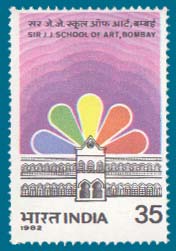
SIR J. J. SCHOOL OF ART, BOMBAY

1857 was a significant year in the history of India in yet another way. This year saw the foundation of Sir J. J. School of Art with the munificent donation of Rs. 1,00,000 from Sir Jamshedji Jeejibhoy the first Baronet. The first drawing class was started at the Elphinstone Institute under the management of a Committee, headed by the then Chief Justice of Bombay. Subsequently in 1866, three ateliers for (i) Decorative Paintings, (ii) Modelling; and (iii) Ornamental Wrought Iron Work were established and the management of the School was taken over by the Government. The School started functioning in, the present building in 1878. Drawing teaching as a subject was introduced in 1879 and facilities for training of Drawing Teachers was started in 1893.
Due attention was also paid for the development of indigenous arts and crafts by this School. Mr. Griffiths who took charge as a Principal of the School in. 1865 undertook the work of copying Ajanta murals in 1872 and finished it in 1881. His efforts with the able assistance of J. J. Students projected the first pictorial record of great Ajanta murals before the public. The students of Modelling atelier also contributed at the same time to the ornamental details on the Victoria Terminus University Building and other buildings in Bombay.
In 1891 the Lord Reay Art Workshops (now known as the Department of Art-Crafts) were established. In 1896, the Draughtsman's classes, the nucleus of the Department of Architecture were added. This Department was later organised for a 3 years Diploma Course which was duly recognised by the R.I.B.A. Board.
In 1910, Sir George Clarks Studies and Laboratories were built for the advanced study of crafts, pottery being the first craft taken up for study. Pottery produced by this Laboratory achieved perfection and was acknowledged in several exhibitions in London, Antwerp, Amsterdam and other places. In 1929, the School was converted into a separate Art Department and the Principal was redesignated as Director. Subsequently in 1935, the Department of Commercial Art was also started.
With the dawn of Independence in 1947, the School saw rapid changes, both administrative and academic. By that time, the first Indian Director, Shri. V.S. Adurkar had been appointed. In view of the expanding activities of the institution, it became inevitable to separate the Departments of Architecture and Applied Art and in 1958 Sir J. J. Institute of Applied Art came into existence. In this year of 125th Anniversary of Sir J. J. School of Art, steps are being taken to elevate the art Diploma to the status of University Degree with a view to widening its academic scope, leading to postgraduate training and research.
Sir J. J. School of Art has played a great role in the cultural development of this country. From this School had come painters, sculptors, architects and graphic designers whose work won warm encomiums and unstinted praise from critics and admirers of India and abroad. The murals painted at the Secretariat complex in New Delhi in 1928 and at National Defence Academy, Khadakwasla in 1954 are few of this School's outstanding contributions. The monumental four tons Bronze Cast of Ashok Emblem at the dome of New Council Hall at, Bombay is one of the recent works skillfully executed by the students and teachers of this school.
Indian P & T Department is happy to issue a commemorative stamp on the occasion of the 125th Anniversary of this Institution.
(The above text is based on material supplied by the sponsors).
Description of Designs: The stamp was designed by M.D. Patel, a student of Sir J. J. Institute of Applied Art, Bombay. The first day cover shows the building of Sir J. J. School of Art, Bombay. Cancellation was designed by Charanjit Lal.
Date of Issue: 2.3.1982